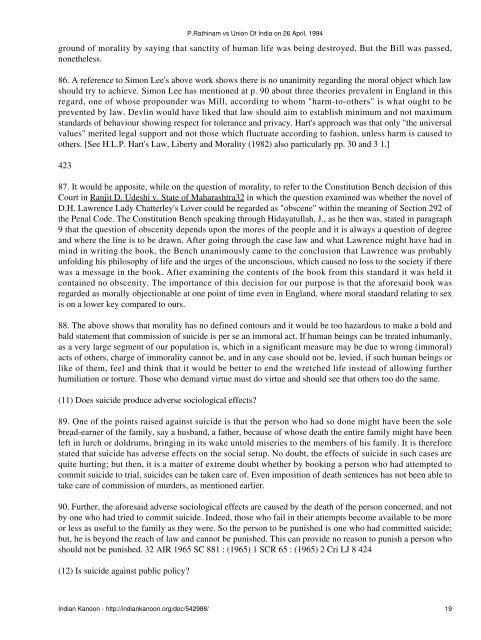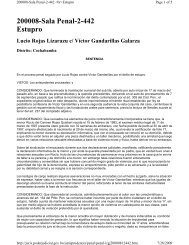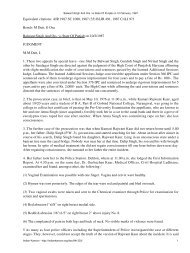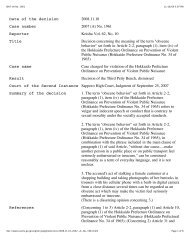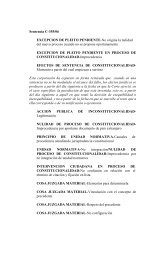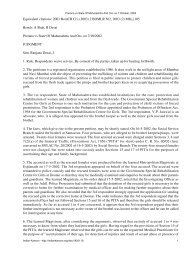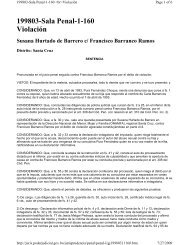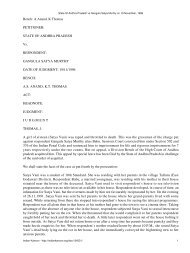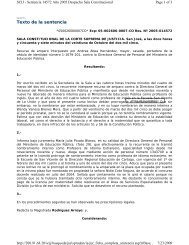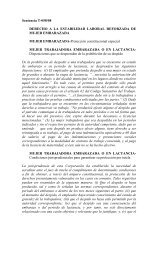P. Rathinam v. Union of India - Cornell University
P. Rathinam v. Union of India - Cornell University
P. Rathinam v. Union of India - Cornell University
- No tags were found...
You also want an ePaper? Increase the reach of your titles
YUMPU automatically turns print PDFs into web optimized ePapers that Google loves.
ground <strong>of</strong> morality by saying that sanctity <strong>of</strong> human life was being destroyed. But the Bill was passed,nonetheless.86. A reference to Simon Lee's above work shows there is no unanimity regarding the moral object which lawshould try to achieve. Simon Lee has mentioned at p. 90 about three theories prevalent in England in thisregard, one <strong>of</strong> whose propounder was Mill, according to whom "harm-to-others" is what ought to beprevented by law. Devlin would have liked that law should aim to establish minimum and not maximumstandards <strong>of</strong> behaviour showing respect for tolerance and privacy. Hart's approach was that only "the universalvalues" merited legal support and not those which fluctuate according to fashion, unless harm is caused toothers. [See H.L.P. Hart's Law, Liberty and Morality (1982) also particularly pp. 30 and 3 1.]42387. It would be apposite, while on the question <strong>of</strong> morality, to refer to the Constitution Bench decision <strong>of</strong> thisCourt in Ranjit D. Udeshi v. State <strong>of</strong> Maharashtra32 in which the question examined was whether the novel <strong>of</strong>D.H. Lawrence Lady Chatterley's Lover could be regarded as "obscene" within the meaning <strong>of</strong> Section 292 <strong>of</strong>the Penal Code. The Constitution Bench speaking through Hidayatullah, J., as he then was, stated in paragraph9 that the question <strong>of</strong> obscenity depends upon the mores <strong>of</strong> the people and it is always a question <strong>of</strong> degreeand where the line is to be drawn. After going through the case law and what Lawrence might have had inmind in writing the book, the Bench unanimously came to the conclusion that Lawrence was probablyunfolding his philosophy <strong>of</strong> life and the urges <strong>of</strong> the unconscious, which caused no loss to the society if therewas a message in the book. After examining the contents <strong>of</strong> the book from this standard it was held itcontained no obscenity. The importance <strong>of</strong> this decision for our purpose is that the aforesaid book wasregarded as morally objectionable at one point <strong>of</strong> time even in England, where moral standard relating to sexis on a lower key compared to ours.88. The above shows that morality has no defined contours and it would be too hazardous to make a bold andbald statement that commission <strong>of</strong> suicide is per se an immoral act. If human beings can be treated inhumanly,as a very large segment <strong>of</strong> our population is, which in a significant measure may be due to wrong (immoral)acts <strong>of</strong> others, charge <strong>of</strong> immorality cannot be, and in any case should not be, levied, if such human beings orlike <strong>of</strong> them, feel and think that it would be better to end the wretched life instead <strong>of</strong> allowing furtherhumiliation or torture. Those who demand virtue must do virtue and should see that others too do the same.(11) Does suicide produce adverse sociological effects?89. One <strong>of</strong> the points raised against suicide is that the person who had so done might have been the solebread-earner <strong>of</strong> the family, say a husband, a father, because <strong>of</strong> whose death the entire family might have beenleft in lurch or doldrums, bringing in its wake untold miseries to the members <strong>of</strong> his family. It is thereforestated that suicide has adverse effects on the social setup. No doubt, the effects <strong>of</strong> suicide in such cases arequite hurting; but then, it is a matter <strong>of</strong> extreme doubt whether by booking a person who had attempted tocommit suicide to trial, suicides can be taken care <strong>of</strong>. Even imposition <strong>of</strong> death sentences has not been able totake care <strong>of</strong> commission <strong>of</strong> murders, as mentioned earlier.90. Further, the aforesaid adverse sociological effects are caused by the death <strong>of</strong> the person concerned, and notby one who had tried to commit suicide. Indeed, those who fail in their attempts become available to be moreor less as useful to the family as they were. So the person to be punished is one who had committed suicide;but, he is beyond the reach <strong>of</strong> law and cannot be punished. This can provide no reason to punish a person whoshould not be punished. 32 AIR 1965 SC 881 : (1965) 1 SCR 65 : (1965) 2 Cri LJ 8 424(12) Is suicide against public policy?P.<strong>Rathinam</strong> vs <strong>Union</strong> Of <strong>India</strong> on 26 April, 1994<strong>India</strong>n Kanoon - http://indiankanoon.org/doc/542988/ 19


